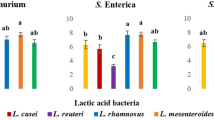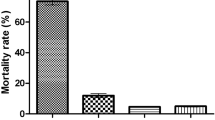Abstract
Pyroligneous acid (PA) was evaluated as a potential alternative to therapeutic antibiotics in poultry. Antimicrobial activity of PA was studied at acidic pH (2.0) and neutral pH (7.0) of the liquid against Salmonella enterica and Lactobacillus acidophilus. Acidic PA gave a MIC value of 0.8% (v/v) and 1.6% (v/v), and neutralized PA gave a MIC value of 1.6% (v/v) and 3.2% (v/v) against S. enterica and L. acidophilus respectively. Acidic PA was evaluated at different concentrations in a simulated poultry digestive tract and cecal fermentation to study its effect on the cecal microflora and fermentation profile. PA at a concentration of 1.6% (v/v) completely inhibited S. enterica and was also found to have a similar effect on lactobacilli count as compared with the control (p = 0.17). Additionally, PA at this concentration was found not to have a significant effect on acetic acid production after 24 h of cecal fermentation (p = 0.20).

Graphical abstract




Similar content being viewed by others
Abbreviations
- GIT:
-
Gastrointestinal tract
- PA:
-
Pyroligneous acid
- SCFA:
-
Short-chain fatty acids
- GC-MS:
-
Gas chromatography-mass spectrometry
- MIC:
-
Minimum inhibitory concentration
- BHI:
-
Brain heart infusion
- MRS:
-
De Man, Rogosa, and Sharpe
- BPLS:
-
Brilliant green phenol red lactose sucrose
- ANOVA:
-
Analysis of variance
References
Yang Y, Tellez G, Latorre JD, Ray PM, Hernandez X, Hargis BM, Ricke SC, Kwon YM (2018) Salmonella excludes Salmonella in poultry: confirming an old paradigm using conventional and barcode-tagging approaches. Front Vet Sci 5:101. https://doi.org/10.3389/fvets.2018.00101
Grant AQ, Hashem F, Parveen S (2016) Salmonella and campylobacter: antimicrobial resistance and bacteriophage control in poultry. Food Microbiol 53(Part B):104–109. https://doi.org/10.1016/j.fm.2015.09.008
Klasing K (1998) Nutritional modulation of resistance to infectious diseases. Poult Sci 77(8):1119–1125
Vandeplas S, Dauphin RD, Beckers Y, Thonart P, Thewis A (2010) Salmonella in chicken: current and developing strategies to reduce contamination at farm level. J Food Prot 73(4):774–785. https://doi.org/10.4315/0362-028X-73.4.774
Card RM, Cawthraw SA, Nunez-Garcia J, Ellis RJ, Kay G, Pallen MJ, Woodward MJ, Anjum MF (2017) An in-vitro chicken gut model demonstrates transfer of a multidrug resistance plasmid from Salmonella to commensal Escherichia coli. MBio 8(4):e00777–e00717. https://doi.org/10.1128/mBio.00777-17
Suresh G, Das RK, Kaur Brar S, Rouissi T, Avalos Ramirez A, Chorfi Y, Godbout S (2018) Alternatives to antibiotics in poultry feed: molecular perspectives. Crit Rev Microbiol 44(3):318–335. https://doi.org/10.1080/1040841X.2017.1373062
Eeckhaut V, Wang J, Van Parys A, Haesebrouck F, Joossens M, Falony G, Raes J, Ducatelle R, Van Immerseel F (2016) The probiotic Butyricicoccus pullicaecorum reduces feed conversion and protects from potentially harmful intestinal microorganisms and necrotic enteritis in broilers. Front Microbiol 7:1416. https://doi.org/10.3389/fmicb.2016.01416
Samanya M, K-e Y (2001) Morphological changes of the intestinal villi in chickens fed the dietary charcoal powder including wood vinegar compounds. J Poult Sci 38(4):289–301. https://doi.org/10.2141/jpsa.38.289
Youn B, Nam K, Chang K, Hwang S, Choe I (2005) Effects of wood vinegar addition for meat quality improvement of old layer. Korean J Poult Sci 32(2):101–106
Grewal A, Abbey L, Gunupuru LR (2018) Production, prospects and potential application of pyroligneous acid in agriculture. J Anal Appl Pyrolysis 135:152–159. https://doi.org/10.1016/j.jaap.2018.09.008
Mathew S, Zakaria ZA (2015) Pyroligneous acid—the smoky acidic liquid from plant biomass. Appl Microbiol Biotechnol 99(2):611–622. https://doi.org/10.1007/s00253-014-6242-1
Watarai S (2005) Eliminating the carriage of Salmonella enterica serovar Enteritidis in domestic fowls by feeding activated charcoal from bark containing wood vinegar liquid (Nekka-Rich). Poult Sci 84(4):515–521. https://doi.org/10.1093/ps/84.4.515
Roy C, Blanchette D, de Caumia B (2000) Industrial scale demonstration of the Pyrocycling (TM) process for the conversion of biomass to biofuels and chemicals. Paper presented at the First World Conference and Exhibition on Biomass for Energy and Industry, Sevilla, Spain, June 5-9, 2000
Suresh G, Pakdel H, Rouissi T, Brar SK, Fliss I, Roy C (2019) In vitro evaluation of antimicrobial efficacy of pyroligneous acid from softwood mixture. Biotechnol Res Innov 3(1):47–53. https://doi.org/10.1016/j.biori.2019.02.004
Fernandez B, Le Lay C, Jean J, Fliss I (2013) Growth, acid production and bacteriocin production by probiotic candidates under simulated colonic conditions. J Appl Microbiol 114(3):877–885. https://doi.org/10.1111/jam.12081
Meimandipour A, Shuhaimi M, Hair-Bejo M, Azhar K, Kabeir BM, Rasti B, Yazid AM (2009) In vitro fermentation of broiler cecal content: the role of lactobacilli and pH value on the composition of microbiota and end products fermentation. Lett Appl Microbiol 49(4):415–420. https://doi.org/10.1111/j.1472-765X.2009.02674.x
Donalson LM, Kim WK, Chalova VI, Herrera P, McReynolds JL, Gotcheva VG, Vidanović D, Woodward CL, Kubena LF, Nisbet DJ, Ricke SC (2008) In vitro fermentation response of laying hen cecal bacteria to combinations of fructooligosaccharide prebiotics with alfalfa or a layer ration. Poult Sci 87(7):1263–1275. https://doi.org/10.3382/ps.2007-00179
Suresh G, Santos DU, Rouissi T, Brar SK, Mehdi Y, Godbout S, Chorfi Y, Ramirez AA (2019) Production and in-vitro evaluation of an enzyme formulation as a potential alternative to feed antibiotics in poultry. Process Biochem 80:9–16. https://doi.org/10.1016/j.procbio.2019.01.023
Giannenas I, Papaneophytou C, Tsalie E, Triantafillou E, Tontis D, Kontopidis G (2014) The effects of benzoic acid and essential oil compounds in combination with protease on the performance of chickens. J Anim Feed Sci 23(1):73–81
Lei F, Yin Y, Wang Y, Deng B, Yu HD, Li L, Xiang C, Wang S, Zhu B, Wang X (2012) Higher-level production of volatile fatty acids in vitro by chicken gut microbiotas than by human gut microbiotas as determined by functional analyses. Appl Environ Microbiol 78(16):5763–5772. https://doi.org/10.1128/AEM.00327-12
Stefanidis SD, Kalogiannis KG, Iliopoulou EF, Michailof CM, Pilavachi PA, Lappas AA (2014) A study of lignocellulosic biomass pyrolysis via the pyrolysis of cellulose, hemicellulose and lignin. J Anal Appl Pyrolysis 105:143–150. https://doi.org/10.1016/j.jaap.2013.10.013
Rattanawut J, Todsadee A, K-e Y (2017) Effects of bamboo charcoal powder including vinegar supplementation on performance, eggshell quality, alterations of intestinal villi and intestinal pathogenic bacteria populations of aged laying hens. Ital J Anim Sci 16(2):259–265. https://doi.org/10.1080/1828051X.2017.1283544
Hou X, Qiu L, Luo S, Kang K, Zhu M, Yao Y (2018) Chemical constituents and antimicrobial activity of wood vinegars at different pyrolysis temperature ranges obtained from Eucommia ulmoides Olivers branches. RSC Adv 8(71):40941–40949. https://doi.org/10.1039/C8RA07491G
Oramahi HA, Yoshimura T, Diba F, Setyawati D (2018) Antifungal and antitermitic activities of wood vinegar from oil palm trunk. J Wood Sci 64(3):311–317. https://doi.org/10.1007/s10086-018-1703-2
Xu H, Zhao J, Yang J, Xie J, Zhang N, Jiang J (2020) Effects of apple and pear wood vinegar components on Pleurotus ostreatus mycelium growth. BioResources 15(2):2961–2970. https://doi.org/10.15376/biores.15.2.2961-2970
Fagernäs L, Kuoppala E, Tiilikkala K, Oasmaa A (2012) Chemical composition of birch wood slow pyrolysis products. Energy Fuel 26(2):1275–1283. https://doi.org/10.1021/ef2018836
Li R, Narita R, Nishimura H, Marumoto S, Yamamoto SP, Ouda R, Yatagai M, Fujita T, Watanabe T (2017) Antiviral activity of phenolic derivatives in pyroligneous acid from hardwood, softwood, and bamboo. ACS Sustain Chem Eng 6(1):119–126. https://doi.org/10.1021/acssuschemeng.7b01265
Butt D (2006) Formation of phenols from the low-temperature fast pyrolysis of radiata pine (Pinus radiata): part II. Interaction of molecular oxygen and substrate water. J Anal Appl Pyrolysis 76(1):48–54. https://doi.org/10.1016/j.jaap.2005.01.009
Wei Q, Ma X, Dong J (2010) Preparation, chemical constituents and antimicrobial activity of pyroligneous acids from walnut tree branches. J Anal Appl Pyrolysis 87(1):24–28. https://doi.org/10.1016/j.jaap.2009.09.006
Harada K, Iguchi A, Yamada M, Hasegawa K, Nakata T, Hikasa Y (2013) Determination of maximum inhibitory dilutions of bamboo pyroligneous acid against pathogenic bacteria from companion animals: an in vitro study. J Vet Adv 3(11):300–305
Abas FZ, Zakaria ZA, Ani FN (2018) Antimicrobial properties of optimized microwave-assisted pyroligneous acid from oil palm fiber. J Appl Pharm Sci 8(07):65–71. https://doi.org/10.7324/JAPS.2018.8711
Choi JY, Shinde PL, Kwon IK, Song YH, Chae BJ (2009) Effect of wood vinegar on the performance, nutrient digestibility and intestinal microflora in weanling pigs. Asian Australas J Anim Sci 22(2):267–274. https://doi.org/10.5713/ajas.2009.80355
Wang HF, Gao K, Wang C, Zhang WM, Liu JX (2013) Effects of feeding bamboo vinegar and acidifier as an antibiotic substitute on the growth performance and intestinal bacterial communities of weaned piglets. Acta Agric Scand A Anim Sci 63(3):143–150. https://doi.org/10.1080/09064702.2013.845244
Kupittayanant P, Kupittayanant S (2017) Effects of wood vinegar on the protection of diarrhea in weaning pigs. Planta Med Int Open 4(S 01):Mo-PO-242. https://doi.org/10.1055/s-0037-1608288
Rattanawut J (2013) Effects of dietary bamboo charcoal powder including bamboo vinegar liquid supplementation on growth performance, fecal microflora population and intestinal morphology in Betong chickens. J Poult Sci:0130109. https://doi.org/10.2141/jpsa.0130109
Funding
This work was supported by the Natural Sciences and Engineering Research Council of Canada (Engage Grant 122842) and Fonds de recherche du Québec - Nature et technologies (FRQNT Equipe).
Author information
Authors and Affiliations
Contributions
All authors contributed to the study conception and design. Material preparation, data collection, and analysis were performed by Gayatri Suresh and Hooshang Pakdel. The first draft of the manuscript was written by Gayatri Suresh, and all authors commented on previous versions of the manuscript. All authors read and approved the final manuscript.
Corresponding author
Ethics declarations
Conflict of interest
The authors declare that they have no conflict of interest.
Additional information
Responsible Editor: Miliane Moreira Soares de Souza.
Publisher’s note
Springer Nature remains neutral with regard to jurisdictional claims in published maps and institutional affiliations.
Highlights
• Pyroligneous acid (PA) produced by softwood pyrolysis and analyzed by GC-MS.
• MIC determined for acidic and neutralized PA against S. enterica and Lactobacillus.
• In vitro cecal fermentation with feed with different PA concentrations for 24 h.
• 1.6% (v/v) PA inhibited Salmonella completely and had no effect on Lactobacilli.
• 1.6% (v/v) PA had no significant effect on SCFA production.
Rights and permissions
About this article
Cite this article
Suresh, G., Pakdel, H., Rouissi, T. et al. Evaluation of pyroligneous acid as a therapeutic agent against Salmonella in a simulated gastrointestinal tract of poultry. Braz J Microbiol 51, 1309–1316 (2020). https://doi.org/10.1007/s42770-020-00294-1
Received:
Accepted:
Published:
Issue Date:
DOI: https://doi.org/10.1007/s42770-020-00294-1




